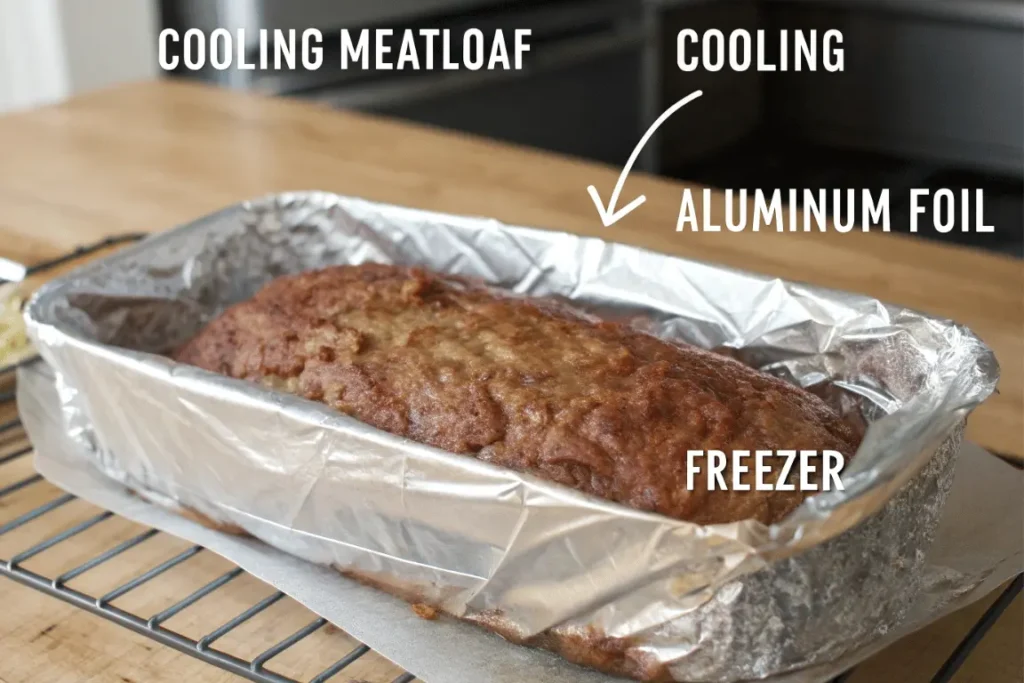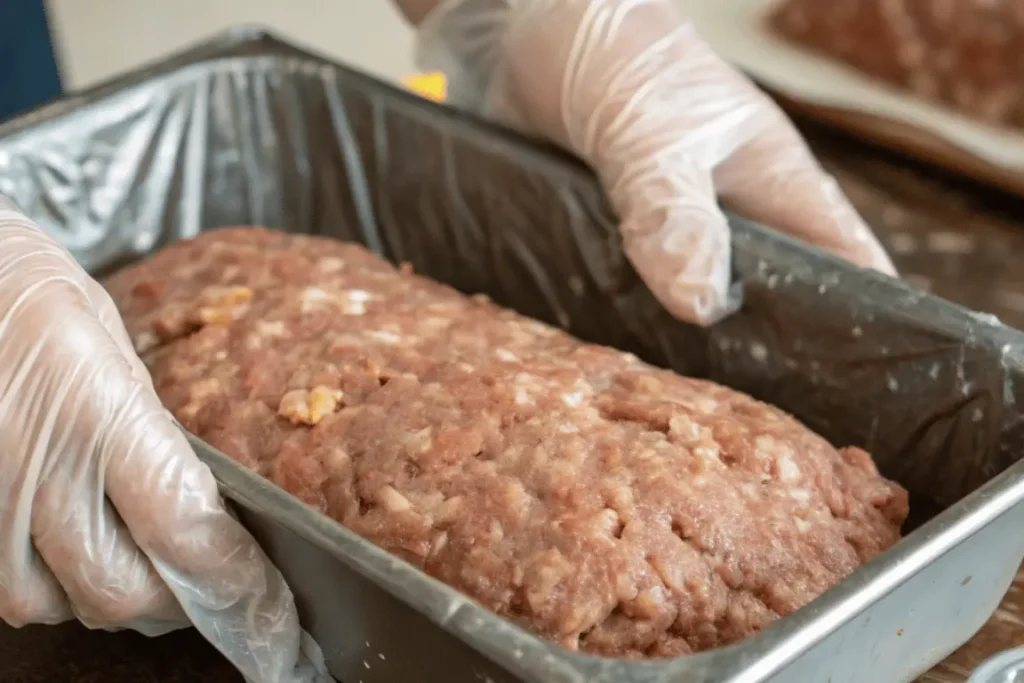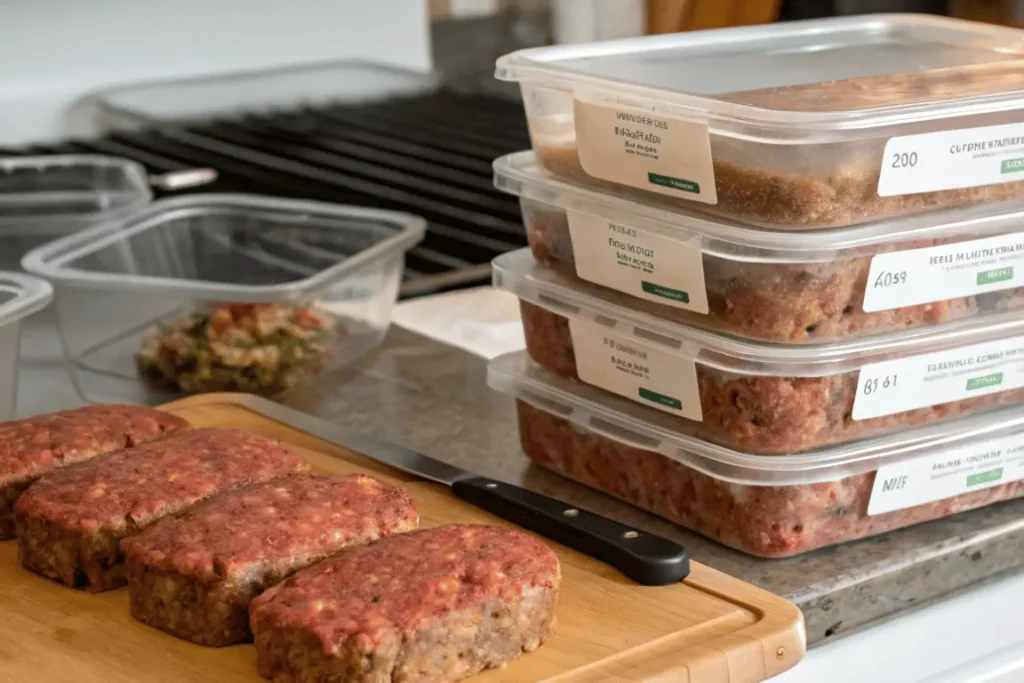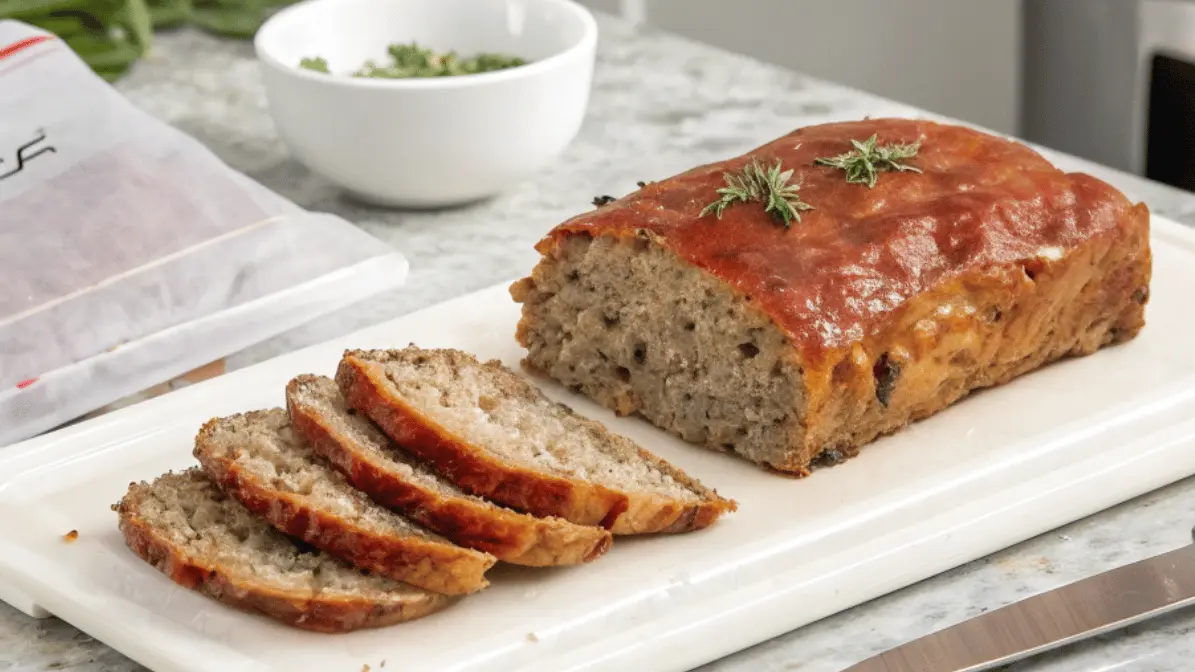Freezing meatloaf the right way can be a total game-changer for busy families, home cooks, or anyone looking to make life a bit easier. Whether you’ve got leftovers or you’re prepping meals ahead of time, knowing how to freeze meatloaf can help stretch your groceries, save your time, and slash food waste. But here’s the catch—not all freezing methods are created equal.
Should you freeze it raw or cooked? Is it okay to freeze meatloaf with eggs or cheese in it? What about thawing and reheating without it turning dry and crumbly?
Don’t worry—we’ve got your back. In this guide, we’ll walk you through the best techniques for freezing both raw and cooked meatloaf, step-by-step. From prepping and packing to thawing and reheating, this no-fluff guide has everything you need to keep your favorite comfort food tasting just as good the second time around.
Let’s dive into the nitty-gritty and help you turn your homemade meatloaf into a freezer-friendly superstar.
Table of Contents
Why Freeze Meatloaf?
Benefits of Freezing Meatloaf
Let’s face it—some nights, cooking from scratch just isn’t in the cards. That’s where freezing comes in clutch. Freezing meatloaf is like pressing pause on a home-cooked meal. You can prep it now and enjoy it later with hardly any extra work. Talk about a win-win!
Besides saving time, freezing helps cut down on food waste. Got leftovers? Don’t toss them! Pop them in the freezer for a rainy day. It’s also perfect for meal planning. Cooking in batches and freezing portions means you’ve always got a ready-to-go dinner that just needs a quick reheat.
Oh, and let’s not forget how budget-friendly this is. Buying meat in bulk or catching a sale? Make a few meatloaves, freeze them raw or cooked, and you’re stocked for weeks.
Raw vs. Cooked: Which Is Better to Freeze?
Now, the million-dollar question: should you freeze your meatloaf before or after it’s cooked?
Both methods have their perks. Freezing raw meatloaf means when you cook it later, it’ll taste super fresh—like it was just made. Plus, it saves oven space on busy cooking days.
On the flip side, freezing cooked meatloaf is great for leftovers or meal-prep lovers. It’s already cooked, so reheating is quicker. You can even freeze it in slices, making it easy to grab what you need.
So, the answer? It depends on your schedule and preference. The good news? We’re going to cover both options in detail so you can choose what works best for you.
How to Freeze Cooked Meatloaf
Preparing Cooked Meatloaf for the Freezer

Once your meatloaf is fully cooked and cooled, it’s time to prep it for the freezer. But wait—don’t rush! Cooling it completely is crucial to prevent condensation, which can lead to ice crystals and freezer burn. No one wants that!
You’ve got options here: freeze it whole, or slice it for single-serving ease. Slicing is especially handy if you’re planning quick lunches or weeknight dinners. It also thaws faster and more evenly.
If you’re using a recipe like this delicious mini meatloaf version, you’re already halfway there. Just cool them, wrap ’em up, and stash them away.
Packaging Techniques for Cooked Meatloaf
So, how do you actually package cooked meatloaf for freezing? You’ve got to block out air—that’s the real freezer villain. Use plastic wrap to seal it tightly, then follow up with a layer of aluminum foil. Double wrapping = double protection.
Even better? Slide the wrapped loaf or slices into a heavy-duty freezer bag. Don’t forget to press out the air and seal it tight. Label it with the date and contents. Future you will thank you.
If you’re feeling extra organized, use stackable freezer containers. Just make sure they’re airtight and BPA-free.
Freezer Storage Time and Temperature Guidelines
So, how long is too long? According to food safety experts, cooked meatloaf can last in the freezer for up to 3 months if stored properly. While it might still be safe beyond that, the taste and texture start to fade.
Always keep your freezer at or below 0°F (-18°C). And here’s a pro tip: if you freeze your meatloaf in small portions, it’s easier to manage and won’t hog your freezer space.
Now that you’ve nailed how to freeze meatloaf after it’s cooked, let’s talk about doing it before it ever hits the oven.
How to Freeze Uncooked (Raw) Meatloaf
Preparing Raw Meatloaf for the Freezer

Freezing meatloaf before cooking? Brilliant move for make-ahead meals! You’ll get that just-baked freshness even weeks later. Just be sure to handle raw meat safely every step of the way.
After mixing your meatloaf ingredients, shape the mixture into a loaf or mini loaves. This helps it freeze evenly and makes it ready to pop straight into the oven. Want to try something different? Freeze it in muffin tins or a tray like the one in this mini meatloaf recipe—portion control, made simple.
Avoid freezing if your recipe has lots of watery veggies or delicate dairy like cream cheese. These don’t freeze well and may mess with the texture later on.
Double Wrapping and Air Removal Techniques
This is the golden rule: wrap it tight and airtight. First, cover your raw meatloaf tightly in plastic wrap. Next, wrap it again with aluminum foil. This helps block air and moisture—two things that can ruin your meatloaf in the freezer.
Want extra insurance? Slide your double-wrapped loaf into a large zip-top freezer bag or a vacuum-sealed pouch. Press out all the air before sealing.
Label the package with the prep date and a “raw” tag. You’ll be amazed how often folks forget if it’s cooked or not.
Storing Raw Meatloaf Safely
The big question: how long can you freeze raw meatloaf? It’s best to use it within 3–4 months. Sure, it might still be safe after that, but freezer flavor (yes, it’s a thing) starts creeping in.
Keep your freezer temp steady—below 0°F is the sweet spot. If your freezer is prone to defrosting cycles, consider using a deep freezer for more reliable long-term storage.
By now, you’re a pro at both methods. But knowing how to freeze meatloaf is just one piece of the puzzle—next, we’ll dive into how to thaw and reheat it for the best taste and texture.
Thawing and Reheating Frozen Meatloaf
Safe Thawing Methods
Thawing meatloaf the right way is just as important as freezing it. If you rush this part, you risk drying it out—or worse, uneven cooking.
The best and safest method? Pop your frozen meatloaf into the refrigerator overnight. Whether it’s raw or cooked, this slow thaw keeps it at a safe temp and helps preserve the texture. For cooked meatloaf slices, you might not even need to thaw; they can go straight into the oven or microwave.
In a pinch? Use the cold water method. Seal the meatloaf in an airtight bag, then submerge it in cold water. Just change the water every 30 minutes. Whatever you do, don’t thaw it on the counter—that’s a recipe for foodborne bacteria.
Reheating Tips Without Drying Out Meatloaf
So, how do you reheat meatloaf and keep it juicy? Easy—cover it. If you’re using the oven, place the loaf or slices in a baking dish with a splash of broth or water. Cover with foil and bake at 325°F until heated through.
Microwaving works too, especially for individual portions. Just use a microwave-safe cover and heat in 30-second bursts to avoid overcooking.
And here’s a pro trick: if your meatloaf looks a little dry, add a dab of ketchup, BBQ sauce, or gravy before heating. Instant upgrade!
How to Cook Raw Frozen Meatloaf
Did you freeze it raw? No problem. You can bake it straight from the freezer—just plan for a longer cook time. Add an extra 30–45 minutes compared to the original recipe. Tent it with foil for the first half, then remove it to brown.
This is one more reason to love learning how to freeze meatloaf the right way—it keeps your options open!
Common Mistakes to Avoid When Freezing Meatloaf
Using the Wrong Containers
It might seem small, but your choice of container can make or break frozen meatloaf. Skip thin plastic wrap or flimsy takeout containers. They let in too much air, which leads to—yep, you guessed it—freezer burn.
Instead, go with heavy-duty freezer bags, airtight containers, or double-wrap in foil and plastic wrap. Trust us, the extra effort pays off in flavor and texture.
And always label your meatloaf clearly. Include the freeze date and whether it’s raw or cooked. That way, you won’t be playing freezer roulette later on.
Freezing Meatloaf with Certain Ingredients
Some ingredients just don’t freeze well. Raw eggs, for instance, can separate. Watery veggies like zucchini may turn mushy. And creamy components (like sour cream) might curdle when thawed.
Stick with simple, freezer-friendly recipes if you’re planning to store your meatloaf. Or better yet, tweak your go-to version to freeze better. For example, use breadcrumbs instead of oats—they hold up better after freezing.
By avoiding these easy-to-miss mistakes, you’ll get better results every time. After all, knowing how to freeze meatloaf is just as much about what not to do.
Make-Ahead Meatloaf: A Freezer Meal Plan
Batch Cooking Tips

If you’re already making one meatloaf, why not double or even triple the recipe? Batch cooking meatloaf is one of the easiest ways to fill your freezer with ready-to-go meals. Just mix up a big batch of your favorite meatloaf base, shape it into multiple loaves (or even muffin-size portions), and prep them for freezing.
This approach saves time, cuts down on clean-up, and helps stretch your grocery budget. You’ll thank yourself later when dinner is just a bake or reheat away!
Don’t forget: when you’re learning how to freeze meatloaf, consistency is key. Shape each loaf evenly and wrap it well to ensure uniform freezing and cooking.
Labeling, Rotating, and Organizing in the Freezer
Don’t underestimate the power of a well-organized freezer! Always label each package with the freeze date and whether the loaf is raw or cooked. Use freezer-safe markers that won’t smear with moisture.
To keep things simple, store newer meatloaves behind older ones so you use the oldest first. That’s first-in, first-out—easy and effective.
You can also group your loaves in bins or baskets by type (raw vs. cooked). This not only saves time when searching but also helps avoid food waste. Smart planning makes all the difference!
FAQs – Freezing Meatloaf Questions Answered
Q: Is it better to freeze meatloaf, cooked or uncooked?
It really depends on your goals. Freezing uncooked meatloaf helps preserve that fresh-made taste once it’s baked later. It’s ideal if you’re prepping ahead for a future meal. On the flip side, freezing cooked meatloaf is a fast way to save leftovers or prep ready-to-reheat meals. Both methods work well if you know how to freeze meatloaf the right way—just wrap tightly and label everything clearly.
Q: How to thaw and reheat frozen meatloaf?
To thaw safely, always move your meatloaf from freezer to fridge and let it defrost overnight. For faster results, you can use the cold water method—just keep it sealed and change the water every 30 minutes.
To reheat cooked meatloaf, cover it with foil and warm in the oven at 325°F until hot (about 20–30 minutes depending on thickness). You can also microwave slices with a splash of broth or sauce to keep them moist. If it’s raw, thaw it first or bake it from frozen—just increase the cook time by 30–45 minutes.
Q: Can you make meatloaf ahead and freeze?
Absolutely! One of the best meal prep hacks is learning how to freeze meatloaf before baking. Just mix, shape, and wrap your meatloaf tightly, then store it in the freezer for up to 3–4 months. On cooking day, simply thaw and bake, or bake straight from frozen. Either way, you save time and still get that fresh-from-the-oven flavor.
Q: Should I thaw frozen meatloaf before cooking?
You don’t have to, but it helps. Thawing frozen meatloaf in the fridge before baking allows it to cook more evenly and quickly. That said, if you’re in a rush, you can cook it straight from frozen—just add extra time and cover with foil for the first part of the baking process. Whether raw or cooked, understanding how to freeze meatloaf gives you flexibility for any kind of busy schedule.
Conclusion: Freezing Meatloaf the Smart Way
Freezing meatloaf isn’t just a handy kitchen trick—it’s a total lifesaver for busy weeknights, last-minute guests, or when you just don’t feel like cooking. Whether you’re prepping ahead with raw loaves or saving leftovers from a hearty dinner, knowing how to freeze meatloaf the right way means you’ll always have a tasty meal within reach.
Just remember the basics: cool it (if cooked), wrap it well, label it clearly, and keep that freezer organized. With a little planning and the tips we’ve shared, you can store your meatloaf safely and serve it later without sacrificing flavor or texture.
So go ahead—double your next recipe, slice up those extras, and stock your freezer like a pro. Your future self (and your hungry family) will thank you.

